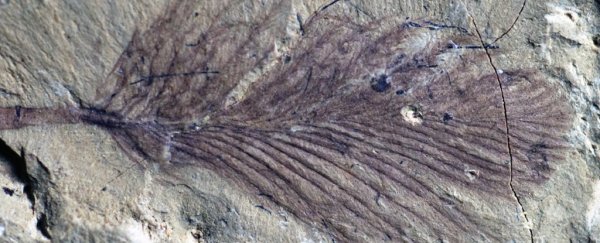Life for dinosaurs living at the South Pole wouldn't have been easy. Sure, it wasn't the icy hellscape it is today, but the long, dark winters still would have been frosty. Now, we have a better idea of how at least some of these animals stayed warm.
A team of scientists from Slovakia, Sweden, Australia, and the US has analysed fossils representing an array of feathers grown by dinosaurs and birds that once lived within the southern polar circle.
While hints of lush feathery dinosaurs have popped up in the fossil record here and there, most examples come from the Northern Hemisphere, representing an array of coverings that could have helped Mesozoic wildlife regulate their temperatures, hide, and occasionally even glide in relatively warm climates.
"Yet, to date, no directly attributable integumentary remains have been discovered to show that dinosaurs used feathers to survive in extreme polar habitats," says Benjamin Kear, a palaeontologist from Uppsala University in Sweden.
That's not to say we're yet to find a single feather fossil in the Southern Hemisphere. A dig site in Australia's southern state of Victoria has given up a few notable examples over the decades. They've just never been looked at closely until now.
"Fossil feathers have been known from Koonwarra since the early 1960s, and were recognised as evidence of ancient birds, but have otherwise received very little scientific attention," says Thomas Rich of the Melbourne Museum in Australia.
"Our study is thus the first to comprehensively document these remains, which include new specimens that were examined using cutting-edge technologies."
A total of ten fossil specimens were included in the study, all dated around 118 million years old, providing solid evidence of wing feathers from ancient birds, tufted dinosaur 'protofeathers', and even partly decomposed body feathers.
The technologies included advanced forms of microscopy and spectroscopy, allowing the team to capture an impressive level of detail from the well-preserved remains, providing information on their anatomy and – in some cases – colouration.
Some of the feathers were relatively advanced, sporting barbed 'zips' similar to modern feathers that helps them interlock for flight, and gives the animal protection against the elements.
But it was the simpler 'fluffy' feathers, like those below, that were of particular interest.
 (Kundrát et al., Gondwana Research, 2019)
(Kundrát et al., Gondwana Research, 2019)
"Dinosaur 'proto-feathers' would have been used for insulation," says lead author Martin Kundrát, of Pavol Jozef Safarik University in Slovakia.
"The discovery of proto-feathers at Koonwarra therefore suggests that fluffy feather coats might have helped small dinosaurs keep warm in ancient polar habitats."
To understand the conditions these dinosaurs lived in, we need to rewind the clock a few hundred million years, when Earth's familiar map of continents would have looked rather different.
Today's southern landmasses - Antarctica, Australia, South America, and Africa, along with India and Arabia – were all mushed together in one giant supercontinent called Gondwana, which sat more or less directly centred on Earth's South Pole.
The world's climate was a lot warmer back then and Gondwana wasn't a winter wonderland all year round. Instead it was far more temperate, with lush ecosystems full of plants and animals.
While it wasn't exactly freezing, the poles still experienced long periods of sunlight in summer, and darkness in winter. So anything living in such extreme conditions still had to deal with an extended, chilly twilight.
Having hard evidence of potentially insulating feathers helps researchers fill in the missing pieces.
The team also found densely packed fossil melanosomes, or pigment bodies, that indicated dark colouration that might help to absorb heat, if not also help with camouflage or communication in those dimly lit months.
Ten years ago, Australian palaeontologists found clear evidence of a 110 million year old 'dino-burrow' in another Victorian dig site, suggesting at least some species could have gone underground to wait out the cold.
There's no doubt a rich variety of features and behaviours that would have helped polar animals live comfortably in such a variable environment; and it's nice to finally have some firm evidence of them.
This research was published in Gondwana Research.
